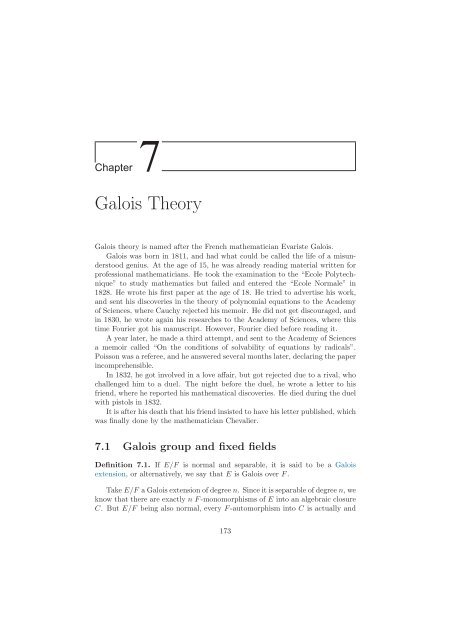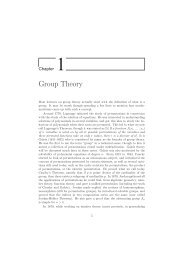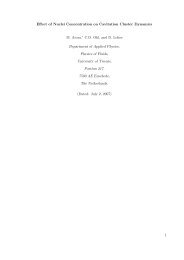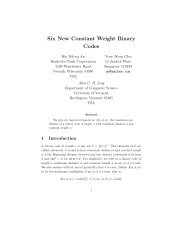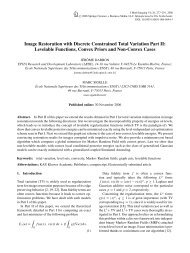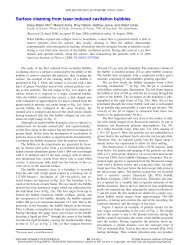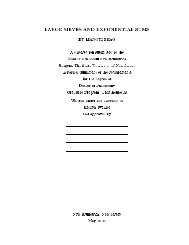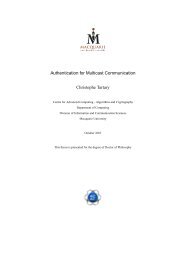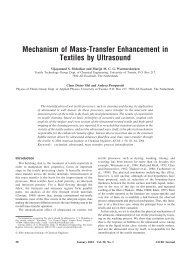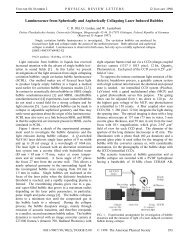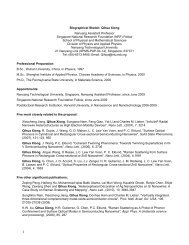Galois Theory
Galois Theory
Galois Theory
Create successful ePaper yourself
Turn your PDF publications into a flip-book with our unique Google optimized e-Paper software.
Chapter 7<strong>Galois</strong> <strong>Theory</strong><strong>Galois</strong> theory is named after the French mathematician Evariste <strong>Galois</strong>.<strong>Galois</strong> was born in 1811, and had what could be called the life of a misunderstoodgenius. At the age of 15, he was already reading material written forprofessional mathematicians. He took the examination to the “Ecole Polytechnique”to study mathematics but failed and entered the “Ecole Normale” in1828. He wrote his first paper at the age of 18. He tried to advertise his work,and sent his discoveries in the theory of polynomial equations to the Academyof Sciences, where Cauchy rejected his memoir. He did not get discouraged, andin 1830, he wrote again his researches to the Academy of Sciences, where thistime Fourier got his manuscript. However, Fourier died before reading it.A year later, he made a third attempt, and sent to the Academy of Sciencesa memoir called “On the conditions of solvability of equations by radicals”.Poisson was a referee, and he answered several months later, declaring the paperincomprehensible.In 1832, he got involved in a love affair, but got rejected due to a rival, whochallenged him to a duel. The night before the duel, he wrote a letter to hisfriend, where he reported his mathematical discoveries. He died during the duelwith pistols in 1832.It is after his death that his friend insisted to have his letter published, whichwas finally done by the mathematician Chevalier.7.1 <strong>Galois</strong> group and fixed fieldsDefinition 7.1. If E/F is normal and separable, it is said to be a <strong>Galois</strong>extension, or alternatively, we say that E is <strong>Galois</strong> over F.TakeE/F a<strong>Galois</strong>extensionofdegreen. Sinceitisseparableofdegreen, weknow that there are exactly n F-monomorphisms of E into an algebraic closureC. But E/F being also normal, every F-automorphism into C is actually and173
174 CHAPTER 7. GALOIS THEORYFigure 7.1: Evariste <strong>Galois</strong> (1811-1832)F-automorphism of E. Thus there are exactly n = [E : F] F-automorphisms ofE.We can define the notion of a <strong>Galois</strong> group for an arbitrary field extension.Definition 7.2. If E/F is a field extension, the <strong>Galois</strong> group of E/F, denotedby Gal(E/F), is the set of F-automorphisms of E. It forms a group under thecomposition of functions.Example 7.1. If E = Q( 3√ 2), then Gal(E/Q) = {1}, that is the identity on E.The above example illustrates the fact that though one can always define a<strong>Galois</strong> group, we need the extension to be actually <strong>Galois</strong> to say that the orderof the <strong>Galois</strong> group is actually the degree of the field extension.Definition 7.3. Let G = Gal(E/F) be the <strong>Galois</strong> group of the extension E/F.If H is a subgroup of G, the fixed field of H is the set of elements fixed by everyautomorphism in H, that isF(H) = {x ∈ E, σ(x) = x for all σ ∈ H}.Vice-versa, if K is an intermediate field, defineG(K) = Gal(E/K) = {σ ∈ G, σ(x) = x for all x ∈ K}.It is the group fixing K.<strong>Galois</strong> theory has much to do with studying the relations between fixed fieldsand fixing groups.Proposition 7.1. Let E/F be a finite <strong>Galois</strong> extension with <strong>Galois</strong> group G =Gal(E/F). Then1. The fixed field of G is F.
7.1. GALOIS GROUP AND FIXED FIELDS 1752. If H is a proper subgroup of G, then the fixed field F(H) of H properlycontains F.Proof. 1. Let F 0 be the fixed field of G (and we have the field extensionsE/F 0 /F). We want to prove that F 0 = F.We first note that if σ is an F-automorphism of E (that is σ is in G),then by definition of F 0 , σ fixes everything in F 0 , meaning that σ is anF 0 -automorphism. Thus the F-automorphisms in the group G coincidewith the F 0 -automorphisms in the group G.Now we further have that E/F 0 is <strong>Galois</strong>: indeed, we have E/F 0 /F withE/F <strong>Galois</strong>thusnormalandseparable, andE/F 0 inheritsbothproperties.We now look at the degrees of the extensions considered:|Gal(E/F 0 )| = [E : F 0 ], |Gal(E/F)| = [E : F],since both are <strong>Galois</strong>. Furthermore by the first remark, the number of F−and F 0 − automorphisms in G coincide:showing that|Gal(E/F 0 )| = |Gal(E/F)|[E : F 0 ] = [E : F]and by multiplicativity of the degreesand F = F 0 .[E : F] = [E : F 0 ][F 0 : F] ⇒ [F 0 : F] = 12. In order to prove that F F(H), let us assume by contradiction thatF = F(H).Since we consider a finite <strong>Galois</strong> extension, we can invoke the Theorem ofthe Primitive Element and claim thatConsider the polynomialE = F(α), α ∈ E. (7.1)f(X) = ∏ σ∈H(X −σ(α)) ∈ E[X].It is a priori in E[X], but we will prove now that it is actually in F[X].Since by contradiction we are assuming that F = F(H), it is enough toproof that f(X) is fixed by H. Indeed, take τ ∈ H, then∏σ∈H(X −τσ(α)) = ∏ σ∈H(X −σ(α))
176 CHAPTER 7. GALOIS THEORYsince τσ ranges over all H as does σ.Thus f(X) ∈ F[X] and f(α) = 0 (σ must be the identity once whileranging through H). Now on the one hand, we havedegf = |H| < |G| = [E : F]since we assume that H is proper and E/F is <strong>Galois</strong>. On the other hand,degf ≥ [F(α) : F] = [E : F]since f is a multiple of the minimal polynomial of α over F (equality holdsif f is the minimal polynomial of α over F), and E = F(α) by (7.1). Wecannot possibly have degf < [E : F] and degf ≥ [E : F] at the sametime, which is a contradiction and concludes the proof.7.2 The fundamental Theorem of <strong>Galois</strong> theoryThe most significant discovery of <strong>Galois</strong> is that (surely not in these terms!)under some hypotheses, there is a one-to-one correspondence between1. subgroups of the <strong>Galois</strong> group Gal(E/F)2. subfields M of E such that F ⊆ M.The correspondence goes as follows:• To each intermediate subfield M, associate the group Gal(E/M) of allM-automorphisms of E:G = Gal : {intermediate fields} → {subgroups of Gal(E/F)}M ↦→ G(M) = Gal(E/M).• To each subgroup H of Gal(E/F), associate the fixed subfield F(H):F : {subgroups of Gal(E/F)} → {intermediate fields}H ↦→ F(H).We will prove below that, under the right hypotheses, we actually have abijection (namely G is the inverse of F). Let us start with an example.Example 7.2. Consider the field extension E = Q(i, √ 5)/Q. It has four Q-automorphisms, given by (it is enough to describe their actions on i and √ 5):σ 1 : i ↦→ i,σ 2 : i ↦→ −i,σ 3 : i ↦→ i,σ 4 : i ↦→ −i,√ √5 ↦→ 5√ √5 ↦→ 5√ √5 ↦→ − 5√5 ↦→ −√5
7.2. THE FUNDAMENTAL THEOREM OF GALOIS THEORY 177thusThe proper subgroups of Gal(E/Q) areand their corresponding subfields areWe thus get the following diagram:Gal(E/Q) = {σ 1 ,σ 2 ,σ 3 ,σ 4 }.{σ 1 },{σ 1 ,σ 2 },{σ 1 ,σ 3 },{σ 1 ,σ 4 }E, Q( √ 5), Q(i), Q(i √ 5).E ❅Q( √ 5) Q(i) Q(i √ 5)❅ 22❅ ❅ 2QTheorem 7.2. Let E/F be a finite <strong>Galois</strong> extension with <strong>Galois</strong> group G.1. The map F is a bijection from subgroups to intermediate fields, with inverseG.2. Consider the intermediate field K = F(H) which is fixed by H, and σ ∈ G.Then the intermediate fieldσK = {σ(x), x ∈ K}is fixed by σHσ −1 , namely σK = F(σHσ −1 ).Proof.1. We first consider the composition of mapsH → F(H) → GF(H).We need to prove that GF(H) = H. Take σ in H, then σ fixes F(H) bydefinition and σ ∈ Gal(E/F(H)) = G(F(H)), showing thatH ⊆ GF(H).To prove equality, we need to rule out the strict inclusion. If H werea proper subgroup of G(F(H)), by the above proposition the fixed fieldF(H) of H should properly contain the fixed field of GF(H) which isF(H) itself, a contradiction, showing thatH = GF(H).
178 CHAPTER 7. GALOIS THEORYNow consider the reverse composition of mapsK → G(K) → FG(K).This time we need to prove that K = FG(K). ButFG(K) = fixed field by Gal(E/K)which is exactly K by the above proposition (its first point).2. It is enough to compute F(σHσ −1 ) and show that it is actually equal toσK = σF(H).F(σHσ −1 ) = {x ∈ E, στσ −1 (x) = x for all τ ∈ H}= {x ∈ E, τσ −1 (x) = σ −1 (x) for all τ ∈ H}= {x ∈ E, σ −1 (x) ∈ F(H)}= {x ∈ E, x ∈ σ(F(H))} = σ(F(H)).We now look at subextensions of the finite <strong>Galois</strong> extension E/F and askabout their respective <strong>Galois</strong> group.Theorem 7.3. Let E/F be a finite <strong>Galois</strong> extension with <strong>Galois</strong> group G. LetK be an intermediate subfield, fixed by the subgroup H.1. The extension E/K is <strong>Galois</strong>.2. The extension K/F is normal if and only if H is a normal subgroup of G.3. If H is a normal subgroup of G, thenGal(K/F) ≃ G/H = Gal(E/F)/Gal(E/K).4. Whether K/F is normal or not, we have[K : F] = [G : H].Proof. 1. That E/K is <strong>Galois</strong> is immediate from the fact that a subextensionE/K/F inherits normality and separability from E/F.2. First note that σ is an F-monomorphism of K into E if and only if σ isthe restriction to K of an element of G: if σ is an F-monomorphism of Kinto E, it can be extended to an F-monomorphism of E into itself thanksto the normality of E. Conversely, if τ is an F-automorphism of E, thenσ = τ| K is surely a F-monomorphism of K into E.Now, this time by a characterization of a normal extension, we haveK/F normal ⇐⇒ σ(K) = K for all σ ∈ G.
7.3. FINITE FIELDS 179Since K = F(H), we just rewriteK/F normal ⇐⇒ σ(F(H)) = F(H) for all σ ∈ G.Now by the above theorem, we know that σ(F(H)) = F(σHσ −1 ), and wehaveK/F normal ⇐⇒ F(σHσ −1 ) = F(H) for all σ ∈ G.We are almost there, we now use again the above theorem that tells usthat F is invertible, with inverse G, to get the conclusion:K/F normal ⇐⇒ σHσ −1 = H for all σ ∈ G.3. To prove this isomorphism, we will use the 1st isomorphism Theorem forgroups. Consider the group homomorphismGal(E/F) → Gal(K/F), σ ↦→ σ| K .This map is surjective (we showed it above, when we mentioned that wecan extend σ| K to σ. Its kernel is given byKer = {σ, σ| K = 1} = H = Gal(E/K).Applying the 1st isomorphism Theorem for groups, we getGal(K/F) ≃ Gal(E/F)/Gal(E/K).4. Finally, by multiplicativity of the degrees:[E : F] = [E : K][K : F].Since E/F and E/K are <strong>Galois</strong>, we can rewriteWe conclude by Lagrange Theorem:|G| = |H|[K : F].[G : H] = |G|/|H| = [K : F].7.3 Finite fieldsWe will provide a precise classification of finite fields.Theorem 7.4. Let E be a finite field of characteristic p.1. The cardinality of E is|E| = p n ,for some n ≥ 1. It is denoted E = F p n.
180 CHAPTER 7. GALOIS THEORY2. Furthermore, E is the splitting field for the separable polynomialf(X) = X pn −Xover F p , so that any finite field with p n elements is isomorphic to E. Infact, E coincides with the set of roots of f.Proof. 1. Let F p be the finite field with p elements, given by the integersmodulo p. Since E has characteristic p, it contains a copy of F p . Thus Eis a field extension of F p , and we may see E as a vector space over F p . Ifthe dimension is n, then let α 1 ,...,α n be a basis. Every x in E can bewritten asx = x 1 α 1 +···+x n α nand there are p choices for each x i , thus a total of p n different elementsin E.2. Let E × be the multiplicative group of non-zero elements of E. If α ∈ E × ,thenα pn −1 = 1by Lagrange’s Theorem, so thatα pn = αfor all α in E (including α = 0). Thus each element of E is a root of f,and f is separable.Now f has at most p n distinct roots, and we have already identified thep n elements of E as roots of f.Corollary 7.5. If E is a finite field of characteristic p, then E/F p is a <strong>Galois</strong>extension, with cyclic <strong>Galois</strong> group, generated by the Frobenius automorphismσ : x ↦→ σ(x) = x p , x ∈ E.Proof. By the above proposition, we know that E is a splitting field for a separablepolynomial over F p , thus E/F p is <strong>Galois</strong>.Since x p = x for all x in F p , we have thatF p ⊂ F(〈σ〉)that is F p is contained in the fixed field of the cyclic subgroup generated by theFrobenius automorphism σ. But conversely, each element fixed by σ is a rootof X p −X so F(〈σ〉) has at most p elements. ConsequentlyF p = F(〈σ〉)andGal(E/F p ) = 〈σ〉.
7.3. FINITE FIELDS 181This can be generalized when the base field is larger than F p .Corollary 7.6. Let E/F be a finite field extension with |E| = p n and |F| = p m .Then E/F is a <strong>Galois</strong> extension and m|n. Furthermore, the <strong>Galois</strong> group iscyclic, generated by the automorphismτ : x ↦→ τ(x) = x pm , x ∈ E.Proof. If the degree [E : F] = d, then every x in E can be written asx = x 1 α 1 +···+x d α dand there are p m choices for each x i , thus a total ofdifferent elements in E, so that(p m ) d = p nd = m/n and m|n.The same proof as for the above corollary holds for the rest.Thus a way to construct a finite field E is, given p and n, to constructE = F p n as a splitting field for X pn −X over F p .Theorem 7.7. If G is a finite subgroup of the multiplicative group of an arbitraryfield, then G is cyclic. Thus in particular, the multiplicative group E × ofa finite field E is cyclic.Proof. The proof relies on the following fact: if G is a finite abelian group, itcontains an element g whose order r is the exponent of G, that is, the leastcommon multiple of the orders of all elements of G.Assuming this fact, we proceed as follows: if x ∈ G, then its order divides rand thusx r = 1.Therefore each element of G is a root of X r −1 and|G| ≤ r.Conversely, |G| is a multiple of the order of every element, so |G| is at least asbig as their least common multiple, that isand|G| ≥ r|G| = r.Since the order of |G| is r, and it coincides with the order of the element gwhose order is the exponent, we have that G is generated by g, that is G = 〈g〉is cyclic.
182 CHAPTER 7. GALOIS THEORYSince E × is cyclic, it is generated by a single element, say α:E = F p (α)and α is called a primitive element of E. The minimal polynomial of α is calleda primitive polynomial.Example 7.3. Consider the following irreducible polynomialg(X) = X 4 +X +1over F 2 . Let α be a root of g(X). A direct computation shows that α isprimitive:α 0 = 1,..., α 4 = α+1,..., α 7 = α 3 +α+1,..., α 14 = 1+α 3 .7.4 Cyclotomic fieldsDefinition 7.4. A cyclotomic extension of a field F is a splitting field E forthe polynomialf(X) = X n −1over F. The roots of f are called nth roots of unity.The nth roots of unity form a multiplicative subgroup of the group E × ofnon-zero elements of E, and thus must be cyclic. A primitive nth root of unityis an nth root of unity whose order in E × is n. It is denoted ζ n .From now on, we will assume that we work in a characteristic char(F) suchthat char(F) does not divide n. (Otherwise, we have n = mchar(F) and 0 =ζ n n −1 = (ζ m −1) char(F) and the order of ζ n is less than n.)Example 7.4. The field Q(ζ p ) where p is a prime and ζ p is a primitive pth rootof unity is a cyclotomic field over Q.Let us look at the <strong>Galois</strong> group Gal(E/F) of the cyclotomic extension E/F.Then σ ∈ Gal(E/F) must map a primitive nth root of unity ζ n to anotherprimitive nth root of unity ζ r n, with (r,n) = 1. We can then identify σ with r,and this shows thatGal(E/F) ≃ U nwhere U n denotes the group of units modulo n. This shows that the <strong>Galois</strong>group is abelian.Example 7.5. Consider the field extension Q(ζ 3 )/Q. We haveThe <strong>Galois</strong> group is given by:X 3 −1 = (X −1)(X 2 +X +1).σ : ζ 3 ↦→ ζ 2 3σ 2 : ζ 3 ↦→ ζ 3
7.4. CYCLOTOMIC FIELDS 183and the group U 3 of units modulo 3 is U 3 = {1,2}. ThusGal(Q(ζ 3 )/Q) = {σ,1} ≃ {2,1} = (Z/3Z) × .Finally, since E/F is <strong>Galois</strong> (under the above assumption)[E : F] = |Gal(E/F)| = ϕ(n)where ϕ(n) is the Euler totient function.From now on, we fix the base field F = Q. This means that a primitive nthroot of unity ζ n is given byζ n = e i2πr/n , (r,n) = 1.Definition 7.5. The nth cyclotomic polynomial is defined byΨ n (X) = ∏(X −ζn),i(i,n)=1where the product is taken over all primitive nth roots of unity in C.The degree of Ψ n (X) is thusExample 7.6. For n = 1,2, we havedeg(Ψ n ) = ϕ(n).Ψ 1 (X) = X −1, Ψ 2 (X) = X −(−1) = X +1.Computing a cyclotomic polynomial is not that easy. Here is a formula thatcan help.Proposition 7.8. We haveX n −1 = ∏ d|nΨ d (X).In particular, if n = p a prime, then d is either 1 or p andfrom which we getX p −1 = Ψ 1 (X)Ψ p (X) = (X −1)Ψ p (X)Ψ p (X) = Xp −1X −1 = Xp−1 +X p−2 +···+X +1.Proof. We prove equality by comparing the roots of both monic polynomials.If ζ is a nth root of unity, then by definitionζ n n = 0and its order d divides n. Thus ζ is actually a primitive dth root of unity, anda root of Ψ d (X).Conversely, if d|n, then any root of Ψ d (X) is a dth root hence a nth root ofunity.
184 CHAPTER 7. GALOIS THEORYExamples 7.7. For n = 3 and 5, we have a prime and thus we can use theabove formula:Ψ 3 (X) = X 2 +X +1Ψ 5 (X) = X 4 +X 3 +X 2 +X +1.For n = 4 the primitive 4rth roots of unity are ±i, and by definitionΨ 4 (X) = (X −i)(X +i) = X 2 +1.Finally for n = 6, the possible values for d are 1,2,3 and 6. ThusΨ 6 (X) =X 6 −1(X −1)(X +1)(X 2 +X +1) = X2 −X +1.From the above examples, it is tempting to say that in general Ψ n (X) hasinteger coefficients. It happens to be true.Proposition 7.9. The nth cyclotomic polynomial Ψ n (X) satisfiesΨ n (X) ∈ Z[X].Proof. We proceed by induction on n. It is true for n = 1 since X −1 ∈ Z[X].Let us suppose it is true for Ψ k (X) where k is up to n−1, and prove it is alsotrue for n.Using the above proposition, we know thatX n −1 = ∏ d|nΨ d (X)= Ψ n (X)The aim is to prove that Ψ n (X) ∈ Z[X]:Ψ n (X) =∏d|n,d
7.4. CYCLOTOMIC FIELDS 185and f(X) and g(X) must be in Z[X].To prove that Ψ n (x) is irreducible, we will actually prove thatΨ n (X) = f(X).To prove the equality, it is enough to show that every root of Ψ n (X) is a rootof f(X).We need the following intermediate result: if p does not divide n, thenf(ζ p n) = 0.Let us prove this result. Suppose by contradiction that this is not the case,namely f(ζ p n) ≠ 0. By (7.2), we havewhich evaluated in X = ζ p n yieldsX n −1 = f(X)g(X),(ζ p n) n −1 = 0 = f(ζ p n)g(ζ p n)implying by our assumption that f(ζ p n) ≠ 0 thatg(ζ p n) = 0,orinotherwords, ζ n isarootofg(X p ). Butbydefinitionofminimalpolynomial,we have that f(X) must then divide g(X p ), that isg(X p ) = f(X)h(X), h(X) ∈ Z[X].Since g(X p ),f(X) and h(X) are in Z[X], we can look at their reduction modulop, that is work in F p [X]. We will denote ¯p(X) the polynomial obtained fromp(X) by taking all its coefficients modulo p: if p(X) = ∑ n∑ i=0 a iX i , then ¯p(X) =ni=0 (a i mod p)X i . Thereforeḡ(X p ) = ¯f(X)¯h(X) ∈ F p [X].By working in F p [X], we are now allowed to write thatand thusḡ(X p ) = ḡ(X) pḡ(X) p = ¯f(X)¯h(X) ∈ F p [X].This tells us that any irreducible factor of ¯f(X) divides ḡ(X) and consequently¯f and ḡ have a common factor. Looking at (7.2) in F p [X] givesX n −¯1 = ¯f(X)¯h(X) ∈ F p [X].Since ¯f and ḡ have a common factor, X n −¯1 has a multiple root, which cannotbe since we have assumed that p does not divide n. This proves the claim.
186 CHAPTER 7. GALOIS THEORYTo summarize, we have just proven that if p does not divide n, then f(ζ p n) isanother root of f. Since all primitive nth roots of unity can be obtained fromζ n by successive prime powers, we have that all primitive nth roots of unity areactually roots of f(X), and we know that there are ϕ(n) of them, which is alsothe degree of Ψ n (X). This concludes the proof, sincedegf(X) ≥ ϕ(n) = deg(Ψ n (X)) ⇒ f(X) = Ψ n (X).7.5 Solvability by radicalsThe question of solvability by radicals is the one of solving polynomial equationsunder the restriction that we are only allowed to perform addition, subtraction,multiplication, division, and taking nth roots.For example, we know (Fontana-Tartaglia, 1535) that for a cubic equationthe solution is given byX 3 +pX = q,√√√√X = 3 q p2 + 327 + q24 + 3 q p2 − 327 + q24 .Bythe16thcenturyallpolynomialequationsofdegreesmallerorequalto4weresolved. The natural question was then: what happens with quintic equations?Eulerfailedtogiveananswer, Lagrange(1770)provedthatitdependsonfindingfunctions of the roots which are unchanged by certain permutations of the roots,and that this approach works up to degree 4 and fails for 5. Abel showed (1824)that quintics are insolvable by radicals. The next question thus became: decidewhether or not a given equation can be solved by radicals. Liouville (1843)found the answer in <strong>Galois</strong>’s papers.The answer is to be found by connecting the problem with field theory asfollows. We first need to define the notion of a radical extension. Informally, aradical extension is obtained by adjoining a sequence of nth roots. For example,to get a radical extension of Q containing√3√5 7+ √ 3 11 +√1+ 4 3√ 4,2we must adjoinα = 3√ 11, β = √ √7+β3, γ = 5 ,δ = 3√ 4,ǫ = 4√ 1+δ.2This can be stated formally:
7.5. SOLVABILITY BY RADICALS 187Definition 7.6. An extension E/F is radical if E = F(α 1 ,...,α n ) where forall i = 1,...,n, there exists an integer n(i) such thatα n(i)i ∈ F(α 1 ,...,α i−1 ), i ≥ 2.The α i ’s are said to form a radical sequence for E/F.Example 7.8. The expression√3√5 7+ √ 3 112is contained in Q(α,β,γ,δ,ǫ), where+ 4 √1+ 3√ 4α 3 = 11,β 2 = 3,γ 5 = 7+β ,δ 3 = 4,ǫ 4 = 1+δ.2Definition 7.7. Let f be a polynomial over a field F of characteristic zero (thisis a simplifying assumption). We say that f is solvable (soluble) by radicals ifthere exists a field E containing a splitting field for f such that E/F is a radicalextension.We want to connect radical extensions and solvable groups. Here is the maintheorem:Theorem 7.11. If F is a field of characteristic zero, and F ⊆ E ⊆ M whereM/F is a radical extension, then the <strong>Galois</strong> group of E/F is a solvable group.Thus a solvable (by radicals) polynomial has a solvable <strong>Galois</strong> group (of asplitting field over the base field).Recall that a group G is solvable if G has a normal series{1} = G r G r−1 ...G 0 = Gwith G i /G i+1 abelian. The proof takes some fair amount of work, though theidea is simple. A radical extension is a series of extensions by nth roots. Suchextensions have abelian <strong>Galois</strong> groups (to be proven though...), so the <strong>Galois</strong>group of a radical extension is made up by fitting together a sequence of abeliangroups (unfortunately, the proof is not that simple...)We can restate the above result in terms of polynomials.Theorem 7.12. Let f be a polynomial over a field E of characteristic zero. Iff is solvable by radicals then its <strong>Galois</strong> group (that is the <strong>Galois</strong> group of itssplitting field) over E is a solvable group.To find a polynomial which is not solvable by radicals, it suffices to find onewhose <strong>Galois</strong> group is not solvable.Lemma 7.13. Let p be a prime, f an irreducible polynomial of degree p overQ. Suppose that f has precisely two non-real zeros in C. Then the <strong>Galois</strong> groupof f over Q is the symmetric group S p .
188 CHAPTER 7. GALOIS THEORYTheorem 7.14. The polynomial X 5 −6X+3 over Q is not solvable by radicals.The proof consists of showing that the polynomial is irreducible over Q, byEisenstein’s criterion. Then f has exactly three real zeros with multiplicity 1each, and the above lemma says that is <strong>Galois</strong> group is S 5 . To conclude, weneed to show that the symmetric group S n is not solvable if n ≥ 5.7.6 Solvability by ruler and compassesThe ancient Greek philosopher Plato believed that the only perfect figures werethe straight line and the circle, and this belief had a great impact in ancientGreek geometry: it restricted the instruments available for performing geometricalconstructions to ruler and compasses.Many constructions can be done just be using ruler and compasses, but threefamous constructions could not be performed:• duplication of the cube: find a cube twice the volume of a given cube.• trisection of the angle: find an angle 1/3 the size of a given angle.• quadrature of the circle: find a square of area equal to those of a givencircle.It is no wonder those problems remained unsolved (again, under these platonicconstraints) since we will see, using our modern tools, that none of themare possible.We start by formalizing the intuitive idea of a ruler and compass construction.Denote by P 0 the set of points in R 2 .• operation 1 (ruler): through any 2 points of P 0 , draw a straight line.• operation 2 (compasses): draw a circle, whose center is a point of P 0 andwhose radius is equal to the distance between some pairs of points in P 0 .Definition 7.8. The points of intersection of any two distinct lines or circles,drawn using operations 1 and 2 are said to be constructible from P 0 if thereexists a sequence r 1 ,...,r n of points of R 2 such that for each i = 1,...,n thepoint r i is constructible from the set P 0 ∪{r 1 ,...,r i−1 }, P i = P i−1 ∪{r i }.We can now bring field theory into play. With each stage, we associate thesubfield of R generated by the coordinates of the points constructed. Denote byK 0 the subfield of R generated by the x- and y-coordinates of the points in P 0 .If r i has coordinates (x i ,y i ), then inductively we defineK i = K i−1 (x i ,y i )to getK 0 ⊆ K 1 ⊆ ... ⊆ K n ⊆ R.
7.6. SOLVABILITY BY RULER AND COMPASSES 189Lemma 7.15. With the above notation, x i and y i are zeros in K i of quadraticpolynomials over K i−1 .Proof. There are 3 cases to consider: line meets line, line meets circle and circlemeets circle. We only give the proof of line meets circle.Take 3 points A = (p,q), B = (r,s), C = (t,u) in K i−1 , then draw a linebetween A and B, and a circle of center C with radius w. The equation of theline AB isx−pr −p = y −qs−qwhile the equation of the circle is(x−t) 2 +(y −u) 2 = w 2 .Solving them yields( ) 2 s−q(x−t) 2 +r −p (x−p)+q −u = w 2 .Now x, the first coordinate of the intersection point, is a zero of a quadraticpolynomial over K i−1 .We note that fields obtained by adjoining the zeroes of a quadratic polynomialare extensions of degree 2.Theorem 7.16. If r = (x,y) is constructible from a subset P 0 ∈ R 2 , and if K 0is the subfield of R generated by the coordinates of the points of P 0 , then thedegrees [K 0 (x) : K 0 ] and [K 0 (y) : K 0 ] are powers of 2.Proof. We have that[K i−1 (x i ) : K i−1 ] = 1 or 2, [K i−1 (y i ) : K i−1 ] = 1 or 2.Using multiplication of degrees, we get[K i−1 (x i ,y i ) : K i−1 ] = [K i−1 (x i ,y i ) : K i−1 (x i )][K i−1 (x i ) : K i−1 ] = 1 or 2 or 4with K i = K i−1 (x i ,y i ). Thus [K n : K 0 ] is a power of 2 implying that [K n :K 0 (x)][K 0 (x) : K 0 ] is a power of 2 from which we conclude that [K 0 (x) : K 0 ] isa power of 2, and similarly for y.We are now ready to discuss the impossibility proofs.Theorem 7.17. The cube cannot be duplicated using ruler and compass constructions.Proof. Take a cube whose side is the unit interval, that is of volume 1. We haveP 0 = {(0,0),(1,0)} and K 0 = Q. If we could duplicate the cube, then we canconstruct a point (α,0) such that the volume α 3 is equal to 2, that isα 3 = 2.
190 CHAPTER 7. GALOIS THEORYNow [Q(α) : Q] is a power of 2, but α is a zero of t 3 −2 which is irreducible (byEisenstein) over Q. This gives that[Q(α) : Q] = 3,a contradiction to the fact that it should be a power of 2.Theorem 7.18. The angle π/3 cannot be trisected using ruler and compassconstructions.Proof. Constructing an angle trisecting π/3 is equal to constructing the point(α,0) given (0,0) and (1,0) where α = cos(π/9). Knowing α = cos(π/9), wecan constructβ = 2cos(π/9).Using that cos(3θ) = 4cos 3 (θ)−3cos(θ) and cos(3θ) = 1/2 when θ = π/9, wehave1 = 8cos 3 (θ)−6cos(θ) ⇒ β 3 −3β −1 = 0.Now f(t) = t 3 −3t−1 is irreducible over Q (apply Eisenstein on f(t+1)) thus[Q(β) : Q] = 3contradicting the fact that it should be a power of 2.Theorem 7.19. The circle cannot be squared using ruler and compass constructions.Proof. Without loss of generality, we assume that the circle is the unit circlecentered at (0,0). Constructing a square with area π is equivalent to constructinga point ( √ π,0). Since the smallest field with 0 and 1 is Q, the field obtainedfrom adjoining ( √ π,0) is Q( √ π). Thus [Q( √ π) : Q] should be a power of 2,and in particular it should be algebraic, which is a contradiction (Lindeman’sTheorem shows the transcendence of π, 1882).The main definitions and results of this chapter are• (4.1). Definitions of: <strong>Galois</strong> extension, <strong>Galois</strong> group,fixed field.• (4.2). The fundamental theorem of <strong>Galois</strong> theory,<strong>Galois</strong> groups of intermediate fields.• (4.3). Characterization of finite fields, their <strong>Galois</strong>group, their multiplicative group.• (4.4). Definition of cyclotomic field, primitive rootof unity, cyclotomic polynomial. The <strong>Galois</strong> group ofa cyclotomic field.
Chapter 8Exercises on <strong>Galois</strong> <strong>Theory</strong>Exercises marked by (*) are considered difficult.8.1 <strong>Galois</strong> group and fixed fieldsExercise 96. Compute the <strong>Galois</strong> group of X 4 − 2 over Q and F 3 , the finitefield with 3 elements.Answer. Over Q, we haveX 4 −2 = (X 2 − √ 2)(X 2 + √ 2) = (X −2 1/4 )(X +2 1/4 )(X −i2 1/4 )(X +i2 1/4 ),while over F 3 , let w be a root of the irreducible polynomial X 2 + X + 2 = 0,thenw 2 = −w+1, w 4 = −1, w 8 = 1andX 4 −2 = X 4 +1 = (X 2 −w 2 )(X 2 +w 2 ) = (X −w)(X +w)(X −w 3 )(X +w 3 ).8.2 The fundamental Theorem of <strong>Galois</strong> theoryExercise 97. 1. Compute the splitting field K of the polynomial f(x) =x 4 −2 ∈ Q(x).2. Show that K is a <strong>Galois</strong> extension.3. Compute the degree of K/Q.4. Compute the Q-automorphisms of K.5. Do you recognize Gal(K/Q)?191
192 CHAPTER 8. EXERCISES ON GALOIS THEORY6. What are all the subgroups of Gal(K/Q)?7. What are all the intermediate subfields of K/Q?8. Among the intermediate subfields, which are normal?Answer.1. We have that f(x) = (x 2 − √ 2)(x 2 + √ 2) = (x− 4√ 2)(x+ 4√ 2)(x+i 4√ 2)(x−i 4√ 2). Thus the splitting field of f is Q(i, 4√ 2).2. It is a splitting field thus K is normal, it is separable because Q is ofcharacteristic zero.3. The degree is[Q( 4√ 2,i) : Q] = [Q( 4√ 2,i) : Q( 4√ 2)][Q( 4√ 2) : Q].TheminimumpolynomialofioverQ( 4√ 2)isx 2 +1,so[Q( 4√ 2,i) : Q( 4√ 2)] =2. Since f(x) is irreducible over Q (by Eisenstein), it is the minimal polynomialof 4√ 2 over Q, thus [Q( 4√ 2) : Q] = 4 and finally the total degree is8.4. There are 8 of them. We haveandσ(i) = i, σ( 4√ 2) = i 4√ 2,τ(i) = −i, τ( 4√ 2) = 4√ 2and we can find the others by combining these two, namely:1 :σ :σ 2 :σ 3 :τ :στ :σ 2 τ :σ 3 τ :4√ √ 2 ↦→42, i ↦→ i4√ √ 2 ↦→ i42 i ↦→ i4√ √ 2 ↦→ −42 i ↦→ i4√ √ 2 ↦→ −i42 i ↦→ i4√ √ 2 ↦→42 i ↦→ −i4√ √ 2 ↦→ i42 i ↦→ −i4√ √ 2 ↦→ −42 i ↦→ −i4√ √ 2 ↦→ −i42 i ↦→ −i5. This is the dihedral group of order 8.6. • order 8: G, order 1: {1}.• order 4: there are 3 of themS = {1,σ,σ 2 ,σ 3 } ≃ C 4 , T = {1,σ 2 ,τ,σ 2 τ} ≃ C 2 ×C 2 , U = {1,σ 2 ,στ,σ 3 τ} ≃ C 2 ×C 2 .
8.2. THE FUNDAMENTAL THEOREM OF GALOIS THEORY 193• order 2, there are 5 of them, all isomorphic to C 2 :A = {1,σ 2 }, B = {1,τ}, C = {1,στ}, D = {1,σ 2 τ}, E = {1,σ 3 τ}.7. By <strong>Galois</strong> correspondence, we obtain the intermediate fiels as fixed fieldsof the subgroups. The subfields of degree 2 are the easiest to find:Q(i), Q( √ 2), Q(i √ 2)which are fixed by resp. S, T and U. By direct computation (that is,apply the automorphism on an element of the larger field, and solve theequation that describes that this element is fixed by this automorphism),we find that the others are:fixed resp. by C, A and B.Q((1+i) 4√ 2), Q(i, √ 2), Q( 4√ 2).8. The normal subgroups of G are G,S,T,U,A,I, thus their correspondingfixed fields are normal extensions of Q.Exercise 98. Let K be the subfield of C generated over Q by i and √ 2.1. Show that [K : Q] = 4.2. Give a primitive element of K and its minimal polynomial.3. Show that Gal(K/Q) ≃ (Z/2Z) 2 .4. Give a list of all the subfields of K.Answer.1. Since K = Q(i, √ 2), we can first build Q( √ 2)/Q which is of degree 2,because x 2 −2 is irreducible, then we check that x 2 +1 is irreducible overQ( √ 2), so we obtain another extension of degree 2, by multiplicativity ofthe degrees, this gives an extension of degree 4.2. For example, ζ 8 , the primitive 8th root of unity, is a primitive element,with minimal polynomial x 4 +1.3. The <strong>Galois</strong> group is given by {1,σ,τ,στ} whereσ : i ↦→ −i, √ 2 ↦→ √ 2, τ : i ↦→ i, √ 2 ↦→ − √ 2.4. There is one for each subgroup of the <strong>Galois</strong> group. Since there are onlysubgroups of order 2 (but for the whole group and the trivial subgroup),we get 3 quadratic field extensions:Q(i), Q( √ 2), Q(i √ 2).
194 CHAPTER 8. EXERCISES ON GALOIS THEORYExercise 99. 1. Show that X 4 −3 = 0 is irreducible over Q.2. Compute the splitting field E of X 4 −3 = 0.3. Compute the <strong>Galois</strong> group of E/Q.4. Can you recognize this group?5. Choose two proper, non-trivial subgroups of the <strong>Galois</strong> group above, andcompute their corresponding fixed subfields.Answer.1. Use Eisenstein with p = 3.2. The roots of X 4 − 3 are i j 4 √ 3, j = 0,1,2,3, thus the splitting field isQ( 4√ 3,i).3. As in previous exercise, with 4√ 3 instead of4√2.4. It is the dihedral group.5. Again as in previous exercise.Exercise 100. Consider the field extensions M = Q( √ 2, √ √3) and E = M(α)where α = (2+ √ 2)(3+ √ 3).1. Show that M is a <strong>Galois</strong> extension of Q with <strong>Galois</strong> group C 2 ×C 2 .2. Denote by σ and τ the generators of the two cyclic groups of (1), so thatthe <strong>Galois</strong> group of M is written 〈τ〉×〈σ〉.Answer.• Compute σ(α 2 )/α 2 and deduce that α ∉ M. What is the degree ofE over Q?• Extendσ toanautomorphismofE andshowthatthisautomorphismhas order 4.• Similarly extend τ to an automorphism of E and compute its order.What is the <strong>Galois</strong> group of E over Q?1. M/Q is clearly <strong>Galois</strong> because it is separable (Q is of characteristic 0) andnormal.2. • Wehaveσ(α 2 )/α 2 = ( √ 2−1) 2 thusσ(α 2 ) = (α( √ 2−1) 2 . IfαwereinM, then σ(α) = ±α( √ 2−1) and σ 2 (α) = α( √ 2−1)(− √ 2−1) = −α,a contradiction (σ 2 (α) = α).• We have σ 2 (α) = −α thus σ 4 (α) = α, σ 4 |M = 1 and σ 2 ≠ 1.
8.2. THE FUNDAMENTAL THEOREM OF GALOIS THEORY 195• We compute that τ(α) = 3−√ 3 √6α, we extend τ and its order is 4. Wethen compute thatστ(α) = 3−√ 3− √ 6 (√ 2−1)α, τ(σ(α) = ( √ 2−1) 3−√ 3√6αso σ and τ anticommute, and they are both of order 3, so the <strong>Galois</strong>group is the quaternion group.Exercise 101. Let L/K be a <strong>Galois</strong> extension of degree 8. We further assumethatthereexistsasubextensionM/K ofdegree4whichisnota<strong>Galois</strong>extension.• Show that the <strong>Galois</strong> group G of L/K cannot be abelian.• Determine the <strong>Galois</strong> group G of L/K.Answer.• A subextension M/K of degree 4 which is not <strong>Galois</strong>, means that thereis a subgroup of order 2 which is not normal in G. Thus G cannot beabelian, since all subgroups of an abelian group are all normal.• The only groups of order 8 which are not abelian are D 4 and Q 8 . All thesubgroups of Q 8 are normal, thus it must be D 4 .Exercise 102. Assume that the polynomial X 4 +aX 2 +b ∈ Q[X] is irreducible.Prove that its <strong>Galois</strong> group is:1. the Klein group if √ b ∈ Q.2. the cyclic group of order 4 if √ a 2 −4b √ b ∈ Q.Answer.1. Set Y = X 2 , thenwithY 2 +aY +b = (Y −y 1 )(Y −y 2 )y 1 = −a+√ a 2 −4b,y 2 = −a−√ a 2 −4b2 2and X = ± √ Y so that the four roots are ± √ y 1 ,± √ y 2 . Now y 1 y 2 = bthus√y1√y2 = √ b ∈ Qand if σ( √ y 1 ) = √ y 2 , then we have thatσ( √ y 2 ) = √ b/σ( √ y 1 ) = √ b/ √ y 2 = √ y 1and all the elements of the <strong>Galois</strong> group have order 2, so that it must bethe Klein group.
196 CHAPTER 8. EXERCISES ON GALOIS THEORY2. We havethusy 1 −y 2 = √ a 2 −4b,√y1√y2 (y 1 −y 2 ) = √ b √ a 2 −4b ∈ Q.Now take σ( √ y 1 ) = √ y 2 and if it were of order 2, then σ( √ y 2 ) = √ y 1 andσ( √ y 1√y2 (y 1 −y 2 )) = √ y 1√y2 (y 2 −y 1 )which contradicts that √ y 1√y2 (y 1 −y 2 ) ∈ Q thus σ is of order 4 and the<strong>Galois</strong> group must be the cyclic group of order 4.8.3 Finite fieldsExercise 103. Identify the finite fields Z[i]/(2+i) and Z[i]/(7).Answer. F 5 and F 49Exercise 104. Considerthefollowingtwopolynomials p(x) = x 2 −x−1 ∈ F 3 [x]and q(x) = x 2 + 1 ∈ F 3 [x]. Consider the fields F 3 [x]/(p(x)) ≃ F 3 (α) wherep(α) = 0 and F 3 [x]/(q(x)) ≃ F 3 (β) where q(β) = 0.1. Compute (α+1) 2 .2. Deduce that the two fields F 3 (α) and F 3 (β) are isomorphic.Answer.1. We have (α+1) 2 = α 2 −α+1 = (α+1)−α+1 = 2 = −1.2. We have that β 2 = −1 by definition of β and we have just shown abovethat (α+1) 2 = −1, thus it is natural to map β to α+1, that is f : F 3 (β) →F 3 (α), a + bβ ↦→ a + b(α + 1). Check that f is a ring homomorphism.Then argue that a field homomorphism is always injective, and that bothfields have same number of elements.Exercise 105. Let F 2 be the finite field with two elements.1. Show that F 2 (β) = F 2 [X]/(q(X)) is afinite field, whereq(X) = X 2 +X+1and q(β) = 0.2. Consider the polynomial r(Y) = Y 2 + Y + β ∈ F 2 (β)[Y], and set L =F 2 (β)[Y]/(r(Y)).Answer.• Is L a field? Justify your answer.• What is the cardinality of L? What is its characteristic? Justify youranswers.
8.3. FINITE FIELDS 1971. It is enough to show that q(X) is irreducible over F 2 , this generates thefinite field F 4 ≃ F 2 (β).2. • We have to see if r(Y) is irreducible over F 4 . It is enough to evaluateit in β and β +1 to see that it is not zero.• This creates an extension of degree 2 of F 4 , that is 16 elements. Ithas characteristic 2.Exercise 106. • Let F p be a finite field, p ≥ 3 a prime number. Show thatthe sum of all the elements of F p is 0.• Let q = p n , p a prime. Show that if q ≠ 2, then the sum of all elements ofF q is 0.• Let q = p n , p a prime. Show that the product of all the non-zero elementsof a finite field F q is -1.Answer.• There are many ways of doing that. Modulo p, one could simply noticethat 1+2+...+p−1 is p(p−1)/2, if p ≥ 3, p is an odd prime, thus p−1is even, (p−1)/2 is an integer and thus mod p we do get 0.• An element a in F q satisfies that a pn = a, that is, it is a root of X pn −X.Now all the roots of this polynomial exactly coincide with the elements ofF q , that is, we can writeX pn −X = ∏a∈F q(X −a).Ifwedeveloptheproduct, wegetthattheterminX pn −1 hasascoefficientsexactly the sum of the elements of F q , which is thus 0.• This follows from above. Now we just factor X from the polynomialX pn −X to getX pn−1 −1 = ∏(X −a).a∈F ∗ qNow −1 corresponds to the constant term of the product, which is exactlythe product over all non-zero elements of the finite field.Exercise 107. Consider the finite fields F 2 ,F 3 and F 4 , and the polynomialP(Y) = Y 3 + Y + 1. Over which of these finite fields is P(Y) irreducible? Ifpossible, construct the corresponding field extension.Answer. Since this polynomial is of degree 3, if it is reducible, that meansthere is at least one linear term, that is one root in the base field. It is thusirreducible over F 2 , however over F 3 , we have that P(1) = 0, and over F 4 , wehave no root. Over F 2 , we get an extension of degree 3, that is F 8 , over F 4 , weget an extension of degree 3, that is F 4 3.
198 CHAPTER 8. EXERCISES ON GALOIS THEORY4.4 Cyclotomic fieldsExercise 108. Let ζ be a primitive 20th root of unity in C, and let E = Q(ζ).• Compute the <strong>Galois</strong> group Gal(E/Q).• How many subfields of E are there which are quadratic extensions of Q?• Determine the irreducible polynomial of ζ over Q.Answer.• We know that Gal(E/Q) ≃ (Z/20Z) ∗ .• There are 3 of them: Q(i √ 5), Q( √ 5) and Q(i).• It is X 8 −X 6 +X 4 −X 2 +1.4.5 Solvability by radicals4.6 Solvability by ruler and compassesExercise 109. True/False.Q1. An extension having <strong>Galois</strong> group of order 1 is normal.Answer.Q1. It’s false! If there is only one element, then it’s the identity. Again Q(α)withα 3 = 2hasa<strong>Galois</strong>groupwithonlytheidentity, anditisnotnormal!


